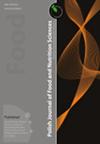Influence of Maturity Stage and Cultivar on the Proximate, Mineral and Amino-Acid Composition of <i>Cocos nucifera</i> L. Kernel from Côte d’Ivoire Coconut Germplasm
IF 2.3
4区 农林科学
Q3 FOOD SCIENCE & TECHNOLOGY
引用次数: 0
Abstract
Cocos nucifera L. is the most important coastal crop in Côte d'Ivoire and its production is the main source of income for farmers. Some 53 coconut cultivars have been developed by the Marc Delorme Coconut Research Station of the Centre National de Recherche Agronomique to provide producers with high-yielding, disease-resistant planting material. However, few data on the biochemical variability of the kernels of these coconut cultivars is known. Therefore, the nutritive characterization of coconut kernels is necessary for the selection of nutrient-rich cultivars for coconut breeding programs and for coconut food valorization. The present study was carried out to evaluate the nutritive composition of four coconut kernel cultivars selected at different maturity stages at the Marc Delorme Coconut Research Station of the National Centre for Agricultural Research. The ANOVA results show a significant effect (p<0.05) of coconut cultivar and maturity stage on kernel nutritive parameters. Moisture, carbohydrate and soluble sugars contents were maximal at 10 months and decreased significantly (p<0.0001) during kernel maturation. Protein, fat, fibre, ash, minerals and amino acids increased significantly (p<0.05) and were maximal at 12 months. The improved West African Tall (WAT+) coconut kernel contains minimum moisture (5.07%), maximum fibre (11.29%), fat (55.42%) and energy (607,41 kcal/100g), while the improved Rennell Island Tall (RIT+) contains maximum carbohydrates (32.13%), reducing sugars (2.78%) and protein (8.63%). The improved hybrid PB113+ also contains maximum ash (1.56%), total sugars (7.24%) and non-reducing sugars (4.98%). Potassium (62488.50 – 74104.34 ppm) and histidine (654.66 – 1287.44 mg/100g) were the predominant minerals and amino acids in coconut kernel. The hybrid cultivars (PB113+ and PB121+) generally had higher mineral and amino acid contents than the tall cultivars (WAT+ and RIT+). These results suggest that there are differences in the nutritional composition of Cocos nucifera kernels between cultivars depending on the stage of maturity. The data obtained will provide useful information for the selection of coconut cultivars and their use in food products.成熟期和品种对椰子树</i>矿物质和氨基酸组成的影响L.取自Côte科特迪瓦椰子种质资源的籽粒
椰子是Côte科特迪瓦最重要的沿海作物,其生产是农民的主要收入来源。法国国家农学研究中心的Marc Delorme椰子研究站开发了大约53个椰子品种,为生产者提供高产、抗病的种植材料。然而,关于这些椰子品种的籽粒生化变异的数据很少。因此,研究椰子籽粒的营养特性对选择营养丰富的品种进行育种和椰子食品增值具有重要意义。本研究在国家农业研究中心Marc Delorme椰子研究站对4个不同成熟期的椰子仁品种的营养成分进行了评价。方差分析结果表明,改良后(p+)椰子仁的水分含量最低(5.07%),纤维含量最高(11.29%),脂肪含量最高(55.42%),能量含量最高(607,41 kcal/100g),而改良后的Rennell Island Tall (RIT+)碳水化合物含量最高(32.13%),还原糖含量最高(2.78%),蛋白质含量最高(8.63%)。改良杂交种PB113+的灰分含量最高(1.56%),总糖含量最高(7.24%),非还原糖含量最高(4.98%)。钾(62488.50 ~ 74104.34 ppm)和组氨酸(654.66 ~ 1287.44 mg/100g)是椰核中主要的矿物质和氨基酸。杂交品种PB113+和PB121+的矿物质和氨基酸含量普遍高于高大品种WAT+和RIT+。这些结果表明,不同品种的椰子籽粒营养成分存在不同的成熟度。所获得的数据将为椰子品种的选择及其在食品中的应用提供有用的信息。
本文章由计算机程序翻译,如有差异,请以英文原文为准。
求助全文
约1分钟内获得全文
求助全文
来源期刊

Polish Journal of Food and Nutrition Sciences
FOOD SCIENCE & TECHNOLOGY-
CiteScore
4.30
自引率
12.50%
发文量
25
审稿时长
20 weeks
期刊介绍:
The Polish Journal of Food and Nutrition Sciences publishes original, basic and applied papers, reviews and short communications on fundamental and applied food research in the following Sections:
-Food Technology:
Innovative technology of food development including biotechnological and microbiological aspects
Effects of processing on food composition and nutritional value
-Food Chemistry:
Bioactive constituents of foods
Chemistry relating to major and minor components of food
Analytical methods
-Food Quality and Functionality:
Sensory methodologies
Functional properties of food
Food physics
Quality, storage and safety of food
-Nutritional Research Section:
Nutritional studies relating to major and minor components of food (excluding works related to questionnaire
surveys)
-“News” section:
Announcements of congresses
Miscellanea
 求助内容:
求助内容: 应助结果提醒方式:
应助结果提醒方式:


